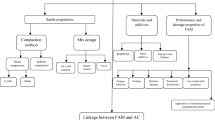Abstract
This study was aimed at investigating the creep behaviour of a typical asphalt concrete containing different percentages of nano-silica. The penetration grade of 60/70 asphalt cement was modified with different percentages of nano-silica (i.e., 1, 3 and 5%, by the weight) and was used for making the asphalt concrete specimens. The asphalt concrete specimens were subjected to dynamic creep tests. Dynamic creep tests were conducted at different stress levels and temperatures. A three-stage model, developed was fitted to the dynamic creep test results to capture the primary, secondary and the tertiary creep regions, and calculate the flow number and the steady-state strain rate in the secondary creep region. The results showed that, the flow number increased, and the steady-state strain rate decreased with increasing nano-silica content, indicating the increase of resistance against permanent deformation.






Similar content being viewed by others
References
Isacsson U and Lu X 1995 Testing and appraisal of polymer modified road bitumens–state of the art. Mater. Struct. 28: 139–159
Airey G D 2003 Rheological properties of styrene butadiene styrene polymer modified road bitumens. Fuel 82(1): 709–719
Yusoff N I M, Breem A A S, Alattug H N M, Hamim A and Ahmad J 2014 The effects of moisture susceptibility and ageing conditions on nano-silica/polymer-modified asphalt mixtures. J. Constr. Build. Mater. 72: 139–147
Whiteoak D and Read J 2005 Shell bitumen handbook. UK, London: Shell Bitumen
Isacsson U and Zeng H 1998 Low-temperature cracking of polymer-modified asphalt. J. Mater. Struct. 31(1): 58–63
Yao H, You Z, Li L, Lee C H, Wingard D, Yap Y K, Shi X and Goh S W 2013 Rheological properties and chemical bonding of asphalt modified with nanosilica. J. Mater. Civil Eng. 25(11): 1619–1630
Scientific Committee on Emerging and Newly Identified Health Risks (SCENIHR) 2006 Modified opinion (after public consultation) on the appropriateness of existing methodologies to assess the potential risks associated with engineered and adventitious products of nanotechnologies. European Commission Health & Consumer Protection Directorate-General
Liu Y L, Hsu C Y, Wei W L and Jeng R J 2003 Preparation and thermal properties of epoxy–silica nanocomposites from nanoscale colloidal silica. Polymer 44: 123–129
[9] Jahromi S G, Andalibizade B and Vossough S 2010 Engineering properties of nanoclay modified asphalt concrete mixtures. Arabian J. Sci. Eng. 35(1B): 89–103
Shafabakhsh G H, Mirabdolazimi S M and Sadeghinejad M 2015 Evaluation the effect of nano-TiO2 on the rutting and fatigue behavior of asphalt mixtures. J. Construct. Build. Mater. 54: 566–572
Shafabakhsh G H and Jafari Ani O 2015 Experimental investigation of effect of Nano TiO2/SiO2 modified bitumen on the rutting and fatigue performance of asphalt mixtures containing steel slag aggregates. J. Construct. Build. Mater. 85: 136–143
You Z, Mills-Beale J, Foley J M, Roy S, Odegard G M, Dai Q and Goh S W 2011 Nanoclay-modified asphalt materials: Preparation and characterization. Construct. Build. Mater. 25(2): 1072–1078
Khattak M J, Khattab A, Rizvi H R and Zhang P 2012 The impact of carbon nano-fiber modification on asphalt binder rheology. Construct. Build. Mater. 30(5): 257–264
Ghile D B 2006 Effects of nanoclay modification on rheology of bitumen and on performance of asphalt mixtures. Delft, The Netherlands: Delft University of Technology
Becker Y, Méndez M P and Rodriguez Y 2001 Polymer modified asphalt. Vis. Technol. 9(1): 39–50
Santagata E, Baglieri O, Tsantilis L and Dalmazzo D 2012 Rheological characterization of bituminous binders modified with carbon nanotubes. Proc. Social Behav. Sci. 53: 546–555
Jahromi S G and Khodaii A 2009 Effects on nanoclay on rheological properties of bitumen binder. Construct. Build. Mater. 23: 2894–904
Polacco G, Kriz P, Filippi S, Stastna J, Biondi D and Zanzotto L 2008 Rheological properties of asphalt/SBS/clay blends. Eur. Polym. J. 44: 3512–3521
Sureshkumar M S, Filippi S, Polacco G, Kazatchkov I, Stastna J and Zanzotto L 2010 Internal structure and linear viscoelastic properties of EVA/asphalt nanocomposites. Eur. Polym. J. 46(4): 621–633
Han N F, Zhou D J and Tang X D 2011 Effect of nano calcium carbonate and montmorillonite on properties of styrene-butadiene-styrene copolymer modified asphalt. J. Appl. Mech. Mater. 99: 1035–1038
Hao X H, Zhang A Q and Yang W 2012 Study on the performance of nano calcium carbonate modified asphalt concrete AC-13. Adv. Mater. Res. 450: 503–507
Yang J and Tighe S 2013 A review of advances of Nanotechnology in asphalt mixtures. Procedia-Social Behav. Sci. 96: 1269–1276
Barik T K, Sahu B and Swain V 2008 Nanosilica—from medicine to pest control. Parasitol. Res. 103(2): 253–258
Chrissafis K, Paraskevopoulos K M, Papageorgiou G Z and Bikiaris D N 2008 Thermal and dynamic mechanical behavior of bionanocomposites: fumed silica nanoparticles dispersed in poly (vinyl pyrrolidone), chitosan, and poly(vinylalcohol). J. Appl. Polym. Sci. 110: 1739–1749
Quercia G and Brouwers H J H 2010 Application of nano-silica (nS) in concrete mixtures. In: 8th fib PhD symposium in Kgs, Lyngby, Denmark
Lazzara G and Milioto S 2010 Dispersions of nano-silica in biocompatible copolymers. Polym. Degrad. Stab. 95: 610–617
CEN EN 12697-25:2016 Bituminous mixtures—test methods. Cyclic compression test, Brussels, CEN
Khodaii A and Mehrara A 2009 Evaluation of permanent deformation of unmodified and SBS modified asphalt mixtures using dynamic creep test. Construct. Build. Mater. 23(7): 2586–2592
Grenfell J R A, Taherkhani H, Collop A C, Airey G D and Scarpas A 2008 Deformation Characterisation of Asphalt Concrete Behaviour (With Discussion). J. Assoc. Asphalt Paving Technologists. 77
Zhou F, Scullion T and Sun L 2004 Verification and modeling of three-stage permanent deformation behavior of asphalt mixes. J. Transport. Eng. 130(4): 486–494
Author information
Authors and Affiliations
Corresponding author
Rights and permissions
About this article
Cite this article
Taherkhani, H., Afroozi, S. Investigating the creep properties of asphaltic concrete containing nano-silica. Sādhanā 43, 24 (2018). https://doi.org/10.1007/s12046-018-0792-3
Received:
Revised:
Accepted:
Published:
DOI: https://doi.org/10.1007/s12046-018-0792-3




